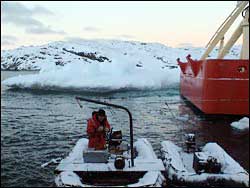European challenges for hydrodynamic modelling in coastal and shelf seas is the focus of the latest report from the European Science Foundation (ESF) Marine Board, released on 6 June at the fourth annual EuroGOOS (Global Ocean Observing System) conference in Brest, France.
Produced by a Marine Board Working Group, chaired by Dr. David Prandle of the Proudman Oceanographic Laboratory in Liverpool, England, the report presents the latest findings from this Group which concentrates
This release from the University of Oxford has been forwarded for your information by Peter Bond, RAS communications officer. Forwarding does not imply endorsement by the RAS.
University of Oxford Press Release
Astrophysicists from the Universities of Oxford and Rome have for the first time found evidence of ripples in the Universe’s primordial sea of neutrinos, confirming the predictions of both Big Bang theory and the Standard Model of particle physics.
Neutrinos are el

Findings show that ice fracturing occurs in episodes and may be tied to changes evolving over seasons
A multifaceted research effort by scientists at Scripps Institution of Oceanography at the University of California, San Diego, and their international colleagues from the University of Tasmania and the Australian Antarctic Division, has resulted in several important new findings about Antarctica and the changing dynamics of its ice structure.
Scientists have been

Reveal Hidden Dangers to Passing Ships
Using inflatable boats, a portable depth sounder with GPS, and a REMUS autonomous underwater vehicle, a team of scientists and engineers has created the first detailed, comprehensive chart of the ocean floor around Palmer Station in Antarctica, revealing previously unknown submerged rocks.
The new chart, the first in 50 years, was made by a research team from the Woods Hole Oceanographic Institution (WHOI) and the University of
Follow the carbon – this is the mantra of researchers seeking to understand climate change and forecast its likely extent. A workshop heard how improved detection of heat-trapping carbon dioxide from space promises to revolutionise carbon cycle understanding.
This week saw more than 60 researchers from Europe, the United States and Japan gather at ESRIN, ESA’s establishment in Italy, for the three-day Carbon from Space workshop, jointly organised by ESA, the Internationa
One of the biggest questions in modern oceanography is how animals in the deep sea get enough to eat. Marine biologists at the Monterey Bay Aquarium Research Institute (MBARI) recently published a paper that helps answer this question, at least for animals that live on the deep seafloor off the coast of Central California. After analyzing hundreds of hours of deep-sea video, Bruce Robison and his colleagues found that “sinkers”—the cast-off mucus nets of small midwater animals called larvacea